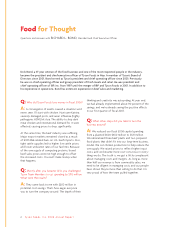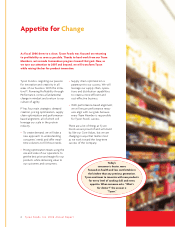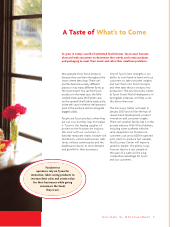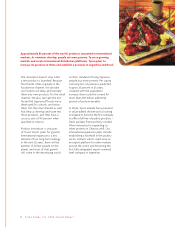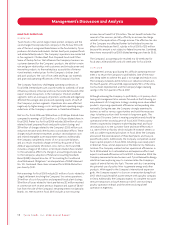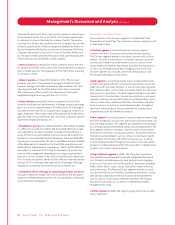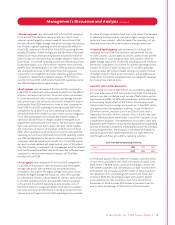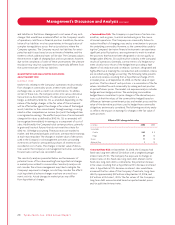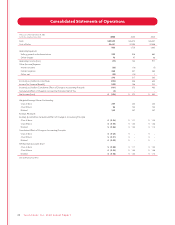Tyson Foods 2006 Annual Report Download - page 14
Download and view the complete annual report
Please find page 14 of the 2006 Tyson Foods annual report below. You can navigate through the pages in the report by either clicking on the pages listed below, or by using the keyword search tool below to find specific information within the annual report.
Cleveland Street Forest, Mississippi, poultry operation ceased oper-
ations in March 2006. Also in July 2005, the Company announced
its decision to close its Bentonville, Arkansas, facility. The produc-
tion from this facility was transferred to the Company’s Russellville,
Arkansas, poultry plant, where an expansion enabled the facility to
absorb the Bentonville facility’s production. In December 2004, the
Company announced its decision to close its Portland, Maine, facil-
ity. The plant ceased operations February 4, 2005, and the production
from this facility was transferred to other locations.
• Interest income increased $20 million, primarily due to the inter-
est earned on the $750 million short-term investment held on deposit
with a trustee used for the repayment of the 7.25% Notes maturing
on October 1, 2006.
• Interest expense increased $31 million or 13.1%. The increase
primarily was due to the increase in average total debt of 15.8%;
however, average total debt increased by approximately 3.2% after
adjusting total debt for the $750 million short-term investment.
The increase was offset partially by a decrease in the overall
weighted average borrowing rate from 7.1% to 7.0%.
• Other income increased $12 million compared to fiscal 2005,
primarily resulting from improvements in foreign currency exchange
gain/loss activity of approximately $7 million and a $7 million gain
recorded on the write-off of a capital lease obligation related to a
legal settlement. These items were offset partially by an $8 million
gain recorded in fiscal 2005 from the sale of the Company’s remain-
ing interest in Specialty Brands, Inc.
• The effective tax rate was a 34.8% benefit for fiscal 2006 compared
to a 29.5% provision for fiscal 2005. The fiscal 2006 effective tax rate
was reduced by 5.1% due to expense recorded in fiscal 2006 as a
result of the tax account balance review as discussed in Note 15 in
the Notes to Consolidated Financial Statements. The fiscal 2006 effec-
tive rate also was reduced by 1.8% due to the federal income tax effect
of the Medicare Part D subsidy loss for fiscal 2006 since this loss is not
deductible for federal income tax purposes. The fiscal 2005 effective
rate reflects a reduction of 4.1% due to the release of income tax
reserves that management deemed were no longer required and a
reduction of 3.6% related to the 2005 estimated future Medicare
Part D subsidy. In addition, the fiscal 2005 effective rate reflected an
increase of 4.2% relating to the repatriation of earnings of foreign
subsidiaries as allowed by the American Jobs Creation Act.
• Cumulative effect of change in accounting principle, net of tax,
includes a transition charge of $5 million related to the Company’s
adoption of FASB Interpretation No. 47, “Accounting for Conditional
Asset Retirement Obligations.”
S E G M E N T I N F O R M AT I O N
Tyson operates in five business segments: Chicken, Beef, Pork,
Prepared Foods and Other. The Company measures segment profit
as operating income.
• Chicken segment is involved primarily in processing live
chickens into fresh, frozen and value-added chicken products.
The Chicken segment markets its products domestically to food
retailers, foodservice distributors, restaurant operators and non-
commercial foodservice establishments such as schools, hotel
chains, healthcare facilities, the military and other food processors,
as well as to international markets throughout the world. The
Chicken segment also includes sales from allied products and
the chicken breeding stock subsidiary.
• Beef segment is involved primarily in processing live fed cattle
and fabricating dressed beef carcasses into primal and sub-primal
meat cuts and case-ready products. It also involves deriving value
from allied products such as hides and variety meats for sale to fur-
ther processors and others. The Beef segment markets its products
domestically to food retailers, foodservice distributors, restaurant
operators and noncommercial foodservice establishments such as
schools, hotel chains, healthcare facilities, the military and other
food processors, as well as to international markets throughout
the world. Allied products also are marketed to manufacturers
of pharmaceuticals and technical products.
• Pork segment is involved primarily in processing live market hogs
and fabricating pork carcasses into primal and sub-primal meat cuts
and case-ready products. This segment also represents the Company’s
live swine group and related allied product processing activities. The
Pork segment markets its products domestically to food retailers,
foodservice distributors, restaurant operators and noncommercial
foodservice establishments such as schools, hotel chains, health-
care facilities, the military and other food processors, as well as
to international markets throughout the world. It also sells allied
products to pharmaceutical and technical products manufacturers,
as well as live swine to pork producers.
• Prepared Foods segment includes the Company’s operations
that manufacture and market frozen and refrigerated food prod-
ucts. Products include pepperoni, beef and pork pizza toppings,
pizza crusts, flour and corn tortilla products, appetizers, prepared
meals, ethnic foods, soups, sauces, side dishes, meat dishes and
processed meats. The Prepared Foods segment markets its prod-
ucts domestically to food retailers, foodservice distributors, restau-
rant operators and noncommercial foodservice establishments
such as schools, hotel chains, healthcare facilities, the military
and other food processors, as well as to international markets
throughout the world.
• Other segment includes the logistics group and other miscella-
neous operations.
12 Ty s o n F o o d s , I n c . 2 0 0 6 A n n u a l R e p o r t
Management’s Discussion and Analysis continued


